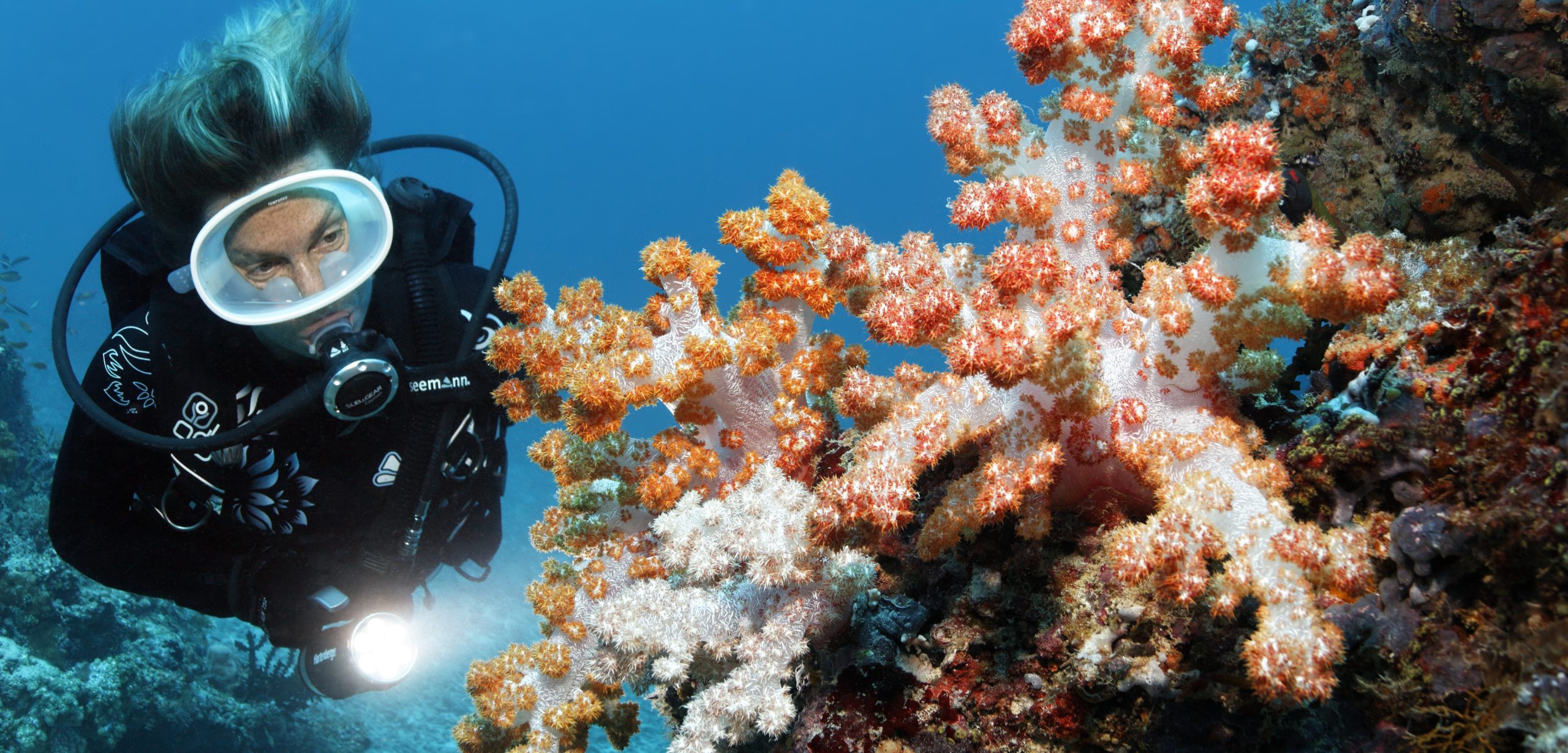Divers: Please Keep Your Hands Off the Coral
Divers routinely damage the coral reefs they’re trying to explore. But a little education goes a long way.
Article body copy
I’ve been on more than 200 dives in at least a dozen different seas, and the most harrowing by far was at night. I was relatively inexperienced, and a night dive to a coral reef sounded thrilling. So, from a boat floating off the Cook Islands, I rolled into the warm Pacific waves and sank to the sea floor.
In the blackness, my enthusiasm turned to anxiety. Then, to fear. An intense surge lurched me back and forth, threatening to slam me into the reef and dozens of spiky sea urchins. A lionfish, bristling with venomous spines, came close enough to kiss; my light attracted stinging jellyfish.
I was breathing so heavily I couldn’t control my buoyancy. Each time the surge thrust me one way, I overcorrected the other.
Though I survived unstung and with air to spare, with all my flailing and kicking the coral may not have been so lucky. I was diving to see the reef, but in the end I likely wound up destroying a small part of it instead. It’s not something I’m proud of, but I’m hardly the only diver with such a story.
Even in daylight and without a current or surge, divers can damage a reef while avoiding other divers, peeking into caves, swimming through overhangs, or inspecting tiny creatures. Whether we’re distracted or disconcerted, it’s easy to grab for the nearest solid object or kick the reef.
Divers were once thought to pose little risk to underwater environments, but today their sheer numbers change the calculation.
“Corals are very fragile and slow-growing organisms, so we need to take greater care not to break them,” says Junko Toyoshima, who recently studied diver behavior in Japan’s popular Ryukyu Islands. Physically damaged coral grows slowly, and is at a greater risk for disease and predation, says Toyoshima in her report.
Over a span of 50 trips, Toyoshima watched as divers kicked the reef or churned up sediment that, when it settled, could gradually kill the coral or slow its growth. Of the 105 divers she observed, only two never touched the reef. For the others, some sort of contact took place roughly every two minutes.
Considering over half a million divers visited the Ryukyu Islands in 2012, Toyoshima calculates that the reef suffered some 160,000 coral breakages that year.
Similarly, in Australia’s Cape Byron and Solitary Islands Marine Parks, 600 divers made a combined 3,179 contacts with the reef or ocean floor, says researcher Zan Hammerton in a new report. Dive fins brake or scrape corals, sponges, and other invertebrates, Hammerton found, and photographers hold on to the reef with their hands or legs to take pictures.
Even divemasters and instructors contact the reef as much, or sometimes more, than less experienced divers, Hammerton found.
“Divemasters and instructors may contact the reef to take a closer look at a specific species, or because they have been diving all week and are tired,” Hammerton says. And, understandably, they may be more focused on the safety of those on the dive than they are on avoiding the reef.
But both Hammerton and Toyoshima say there are ways divers can minimize the risks they pose to coral reefs.
Pre-dive briefings that emphasize the importance of avoiding touching the reef lead to fewer diver contacts, Hammerton showed. Divers who receive in-water reminders are even more careful.
But even with an understanding and appreciation of coral’s vulnerability, it still comes down to skill.
Divers need more buoyancy control training in certification courses, both for their own safety and for that of the environment, Toyoshima says, and experience alone isn’t enough. “Surprisingly, I found even some divers with more than 200 dives could not adequately control buoyancy while a young female with only 10 dives could,” she says.
Toyoshima says that divers should secure loose items, such as gauges and spare regulators, so they don’t drag—a problem Hammerton saw as well—and refrain from using cameras until they’ve mastered buoyancy control. Learning more about marine life can also reduce the likelihood of mistaking a coral for a rock, she says.
Divemasters can lessen divers’ penchant for destruction by picking dive sites to match divers’ skills, using mooring buoys instead of anchoring to the reef, and canceling trips when weather or water conditions are poor, since divers are more likely to cause damage under surges and strong currents, Toyoshima says.
From a conservation perspective, it seems, diving is a mixed bag.
“The great benefit of diving to the marine environment is, of course, influencing the diver’s mind to support conservation by knowing more about marine life,” Toyoshima says.
And as a diver’s appreciation grows, so too, hopefully, does their skill—and the odds the coral will survive another dive.

